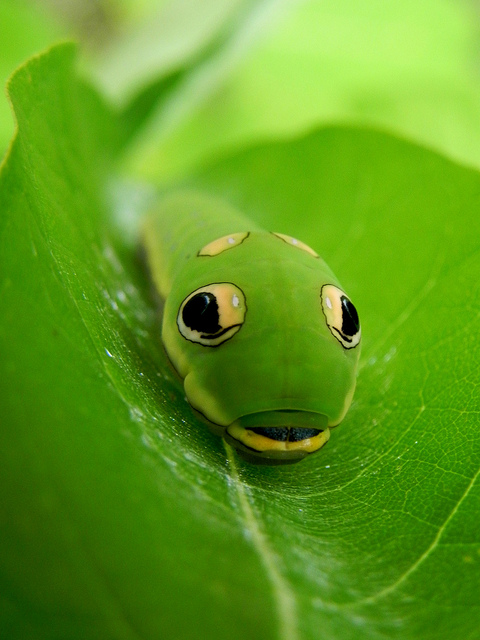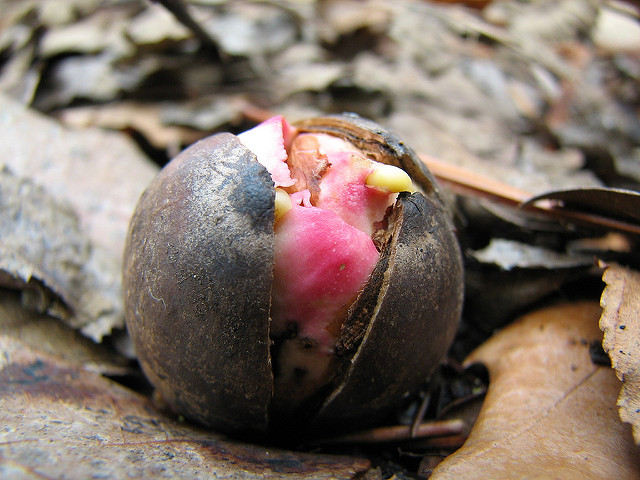The sky swings gently above me as I rest in the hammock my kids bought me on a long ago Father’s Day. The tree that is shading me swings back and forth as well, coming in and out of focus with the swaying of the hammock. This is one of the best places to spend time on these hot days, in a hammock with a cold drink and a few minutes of quiet.
The tree above me is a Red Maple. From where I lay, holes in the leaves appear and disappear as dots of blue sky shining through. The tree was carefully chosen to grow fast and shade my children as they grew and, surprisingly, the hammock swaying gently under me. It was also chosen to be eaten by insects.

Caterpillars, such as the Spicebush Swallowtail, come in all shapes and sizes. Many only eat one or a few types of plants and will starve rather than eat something else. Photo by Jeff Tome
That may seem like a weird choice to some people, but this choice was based on a book that changed how I looked at landscaping right when I had land to scape. The book was “Bringing Nature Home” by Douglas Tallamy.
The core of the book is simple. Animals eat bugs. Many bugs eat plants. If plants from other continents are planted, few native bugs eat them. This means fewer bugs, but also fewer other animals. It takes 6,000 to 9,000 insects, mostly caterpillars, to raise one family of chickadees.
Think about that for a second. Young chickadees leave the nest at around two weeks old. That means that the parents have to find 400 to 600 caterpillars EVERY day. That is a lot of caterpillars to find, especially since the parents rarely travel much more than 50 yards looking for food.
This fact was brought home by Doug Tallamy in person, when he spoke at the Wild America Festival at Panama Rocks a few weeks ago. His program really brought home the value of planting natives. What trees support the caterpillars that feed the birds? Which ones support no insect life?
His book made the concept of “my yard” evaporate. It is not just a yard now, but one piece of green in a quilted neighborhood of green spaces required by animals to survive. Those animals need native plants to support the insects that they catch to raise their young. Most of these insects are more protein-rich than beef and provide huge amounts of food for birds. This new way of thinking about the yard is called “ecosystem gardening.”
An ecosystem is a community of interacting organisms and their environment. Ecosystem gardening is using native plants to make the yard one part of the larger habitat throughout the neighborhood.
Which brings us back to the hammock. The Red Maple over the hammock was chosen because it provides a home to insects and provides shade. Native maples can support almost 300 species of caterpillar. A Red Oak in the corner is almost as tall and was planted by my daughter when she was a year and a half old. Native oaks can support over 400 different caterpillars.
Native plantings along the back of the lot have started to go wild and need to be tamed, but there are great plants there for insects to eat. A variety of milkweeds had Monarch eggs on them last night. The Joe Pye Weed has trails through the leaves from insects that ate them. Black Eyed Susans and coneflowers attract birds, bees and insects to eat the flowers, seeds, and leaves. Towering over all of them is Ironweed, an eight-foot-tall plant with bright purple flowers that attracts all kinds of insects.

Oak trees are easily grown from acorns. One nine-year-old oak is over 15 feet tall. Photo by Jeff Tome.
The yard has some thought behind it. The yard is full of violets for fritillary caterpillars. Virginia Creeper climbs an old metal pole and provides food for several kinds of caterpillars. A row of Spicebush sports snakelike Spicebush Swallowtail caterpillars. The blueberry bushes not only provide yumminess for me, but also insects that eat the leaves.
More and more bird nests are found in my yard each year. At peak nesting time in June, there were Blue Jays, Mourning Doves, robins, Song Sparrows, cardinals and two pairs of chickadees nesting in the yard. Since then, several more robin families, another cardinal family, two more sets of Mourning Doves and two families of House Wrens were also raised there.
My yard doesn’t have enough food for all those young. That is literally 35,000 to 50,000 or more caterpillars coming out of the area. My neighborhood is full of big old native trees, from beautiful oaks and Black Walnuts to huge Silver Maples and Black Cherry trees.
Some of the biggest trees have been there the longest, but provide little to no food for the birds. An ancient Norway Maple that may be older than my house towers nearby, but few to no insects dine on the leaves. Bradford Pears are equally unpalatable to local insects. Both are non-natives, but often planted in city and suburban landscapes.
In some ways, planting trees and plants from another country is like filling a salad bar with Poison Ivy. It may look pretty and green, but there is no way that I’m filling my plate. Many insects will starve before they recognize those plants as food.
My yard is not a well-manicured paradise. It is a wild ramble of plants, trees, raspberries and wildflowers with overgrown grass in the middle. That, however, has less to do with my plant choices than my personality. It is easy and possible to add a few well-manicured native plants into the landscape and keep a neat aesthetic. It is not hard when planting a new tree to find one that is native to the area and plant it. Some neighborhood trees have been transplanted from the forest or grown by kids from seeds.
Fall is a great time to plant new things in the yard. Trees and shrubs plant well in the fall, as do many seeds and seedlings. Take a few moments, right now, to picture your yard as an animal sees it. Is it a smorgasbord of plants that provide insects with food so the birds love it? Or is it a green desert full of plants that are pretty, but serve little to no purpose for local wildlife? Is there room out there for a few milkweeds or a native oak that can help provide food for nesting birds? If we each plant just a few things, it could make all the difference.
Audubon Community Nature Center builds and nurtures connections between people and nature. ACNC is located just east of Route 62 between Warren and Jamestown. The trails are open from dawn to dusk as is Liberty, the Bald Eagle. The Nature Center is open from 10 a.m. until 4:30 p.m. daily except Sunday when it opens at 1 p.m. More information can be found online at auduboncnc.org or by calling (716) 569-2345.
Jeff Tome is a naturalist at the Audubon Community Nature Center.


Recent Comments